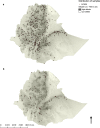Glucose-6-phosphate dehydrogenase (G6PD) deficiency in Ethiopia: absence of common African and Mediterranean allelic variants in a nationwide study
- PMID: 30367627
- PMCID: PMC6204031
- DOI: 10.1186/s12936-018-2538-4
Glucose-6-phosphate dehydrogenase (G6PD) deficiency in Ethiopia: absence of common African and Mediterranean allelic variants in a nationwide study
Abstract
Background: Building on the declining trend of malaria in Ethiopia, the Federal Ministry of Health aims to eliminate malaria by 2030. As Plasmodium falciparum and Plasmodium vivax are co-endemic in Ethiopia, the use of primaquine is indicated for both transmission interruption and radical cure, respectively. However, the limited knowledge of the local prevalence of glucose-6-phosphate dehydrogenase (G6PD) deficiency and its associated variants has hindered the use of primaquine.
Methods: Some 11,138 dried blood spot (DBS) samples were collected in 2011 as part of a national, household Malaria Indicator Survey, a multi-stage nationally representative survey of all malaria-endemic areas of Ethiopia. A randomly selected sub-set of 1414 DBS samples was successfully genotyped by polymerase chain reaction-restriction fragment length polymorphism (PCR-RFLP) technique. Considering the geographical position and ethnic mix of the country, three common variants: G6PD*A (A376G), G6PD*A- (G202A) and Mediterranean (C563T) were investigated.
Results: Of the 1998 randomly selected individuals, 1429 (71.5%) DBS samples were genotyped and merged to the database, of which 53.5% were from females. G6PD*A (A376G) was the only genotype detected. No sample was positive for either G6PD*A- (G202A) or Mediterranean (C563T) variants. The prevalence of G6PD*A (A376G) was 8.9% [95% confidence interval (CI) 6.7-11.2] ranging from 12.2% in the Southern Nations, Nationalities and Peoples' (95% CI 5.7-18.7) to none in Dire Dawa/Harari Region.
Conclusion: The common G6PD*A- (G202A) or Mediterranean (C563T) variants were not observed in this nationwide study. The observed G6PD*A (A376G) mutation has little or no clinical significance. These findings supported the adoption of primaquine for P. falciparum transmission interruption and radical cure of P. vivax in Ethiopia. As the presence of other clinically important, less common variants cannot be ruled out, the implementation of radical cure will be accompanied by active haematological and adverse events monitoring in Ethiopia.
Keywords: Ethiopia; G6PD deficiency; Malaria; Primaquine.
Figures


References
-
- WHO. World malaria report 2017. Geneva, World Health Organization, 2017. http://www.who.int/malaria/publications/world-malaria-report-2017/en/. Accessed 15 Jan 2018.
-
- Federal Ministry of Ethiopia (FMOH). National Malaria Elimination Roadmap. National Malaria prevention, control and elimination programme; Disease Prevention and Control Directorate; 2016.
-
- Beutler E. G6PD deficiency. Blood. 1994;84:3613–3636. - PubMed
MeSH terms
LinkOut - more resources
Full Text Sources
Medical
Research Materials
Miscellaneous

